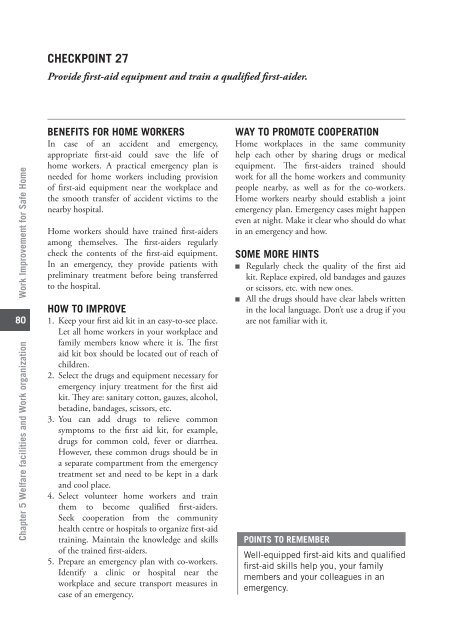Work Improvement for Safe Home - International Labour Organization
Work Improvement for Safe Home - International Labour Organization
Work Improvement for Safe Home - International Labour Organization
Create successful ePaper yourself
Turn your PDF publications into a flip-book with our unique Google optimized e-Paper software.
<strong>Work</strong> <strong>Improvement</strong> <strong>for</strong> <strong>Safe</strong> <strong>Home</strong><br />
80<br />
Chapter 5 Welfare facilities and <strong>Work</strong> organization<br />
CHECKPOINT 27<br />
Provide fi rst-aid equipment and train a qualifi ed fi rst-aider.<br />
BENEFITS FOR HOME WORKERS<br />
In case of an accident and emergency,<br />
appropriate fi rst-aid could save the life of<br />
home workers. A practical emergency plan is<br />
needed <strong>for</strong> home workers including provision<br />
of fi rst-aid equipment near the workplace and<br />
the smooth transfer of accident victims to the<br />
nearby hospital.<br />
<strong>Home</strong> workers should have trained fi rst-aiders<br />
among themselves. Th e fi rst-aiders regularly<br />
check the contents of the fi rst-aid equipment.<br />
In an emergency, they provide patients with<br />
preliminary treatment be<strong>for</strong>e being transferred<br />
to the hospital.<br />
HOW TO IMPROVE<br />
1. Keep your fi rst aid kit in an easy-to-see place.<br />
Let all home workers in your workplace and<br />
family members know where it is. Th e fi rst<br />
aid kit box should be located out of reach of<br />
children.<br />
2. Select the drugs and equipment necessary <strong>for</strong><br />
emergency injury treatment <strong>for</strong> the fi rst aid<br />
kit. Th ey are: sanitary cotton, gauzes, alcohol,<br />
betadine, bandages, scissors, etc.<br />
3. You can add drugs to relieve common<br />
symptoms to the fi rst aid kit, <strong>for</strong> example,<br />
drugs <strong>for</strong> common cold, fever or diarrhea.<br />
However, these common drugs should be in<br />
a separate compartment from the emergency<br />
treatment set and need to be kept in a dark<br />
and cool place.<br />
4. Select volunteer home workers and train<br />
them to become qualifi ed fi rst-aiders.<br />
Seek cooperation from the community<br />
health centre or hospitals to organize fi rst-aid<br />
training. Maintain the knowledge and skills<br />
of the trained fi rst-aiders.<br />
5. Prepare an emergency plan with co-workers.<br />
Identify a clinic or hospital near the<br />
workplace and secure transport measures in<br />
case of an emergency.<br />
WAY TO PROMOTE COOPERATION<br />
<strong>Home</strong> workplaces in the same community<br />
help each other by sharing drugs or medical<br />
equipment. Th e fi rst-aiders trained should<br />
work <strong>for</strong> all the home workers and community<br />
people nearby, as well as <strong>for</strong> the co-workers.<br />
<strong>Home</strong> workers nearby should establish a joint<br />
emergency plan. Emergency cases might happen<br />
even at night. Make it clear who should do what<br />
in an emergency and how.<br />
SOME MORE HINTS<br />
■ Regularly check the quality of the fi rst aid<br />
kit. Replace expired, old bandages and gauzes<br />
or scissors, etc. with new ones.<br />
■ All the drugs should have clear labels written<br />
in the local language. Don’t use a drug if you<br />
are not familiar with it.<br />
POINTS TO REMEMBER<br />
Well-equipped fi rst-aid kits and qualifi ed<br />
fi rst-aid skills help you, your family<br />
members and your colleagues in an<br />
emergency.

















